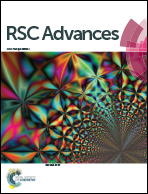Silyl-naphthalene endoperoxides as switchable sources of singlet oxygen for bactericidal activity†
Abstract
Singlet oxygen is a short half-life cytotoxic agent which can be generated by chemical and photochemical methods. In order to make use of its antibacterial action at a selected location, it is desirable to have singlet oxygen in a relatively stable, “caged” structure, in the form of an endoperoxide. Here, the trimethylsilyl (TMS) group supplies the steric bulk, inhibiting the cycloreversion reaction to produce very little singlet oxygen under ambient conditions. However, when fluoride ions are added as tetrabutylammonium fluoride, very rapid removal of the TMS group takes place, followed by the unhindered cycloreversion, releasing singlet oxygen much faster. The bactericidal action on surfaces was demonstrated using E. coli, and imaged under fluorescence microscopy. Considering the issues related to emergence of antibiotic resistant bacterial strains, “on demand singlet oxygen” appears to be an exciting alternative.



 Please wait while we load your content...
Please wait while we load your content...